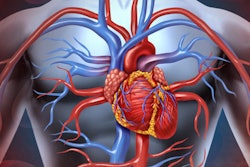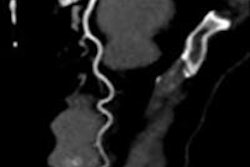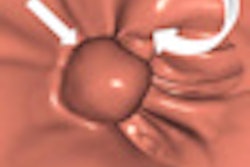In a study of more than 15,000 patients who underwent coronary CT angiography (CCTA), few individuals with mild or moderate disease needed invasive procedures, confirming CT's role as a cost-efficient gateway exam for patients with suspected coronary artery disease (CAD), researchers wrote in the Journal of the American College of Cardiology.
In a kind of referendum on CT's efficiency in avoiding needless invasive angiography procedures, investigators benefited from one of the largest-ever patient cohorts studied -- part of the Coronary CT Angiography Evaluation for Clinical Outcomes (CONFIRM) database that now totals more than 23,000 patients.
The results are a solid demonstration of CCTA's gatekeeper role vis-à-vis invasive coronary angiography, wrote lead investigator Leslee Shaw, PhD, from Emory University, and colleagues at several other centers across the U.S. Optimal targeting of high-risk patients with CAD based on CCTA may facilitate targeted intervention and improve outcomes of patients undergoing a diagnostic workup for suspected coronary artery disease (JACC, October 17, 2012).
Reducing cath utilization
Catheterizations performed without initial CCTA are often negative in patients with suspected coronary artery disease, who typically show up in emergency rooms complaining of chest pain. But the cost of catheterization is high, and the risk is also elevated due to the invasive nature of catheterization; CCTA in these cases is often performed to determine if invasive intervention can be avoided.
"There's been a lot of talk about downstream utilization of cath and whether CTA is an effective filter, so I think that's what drove this analysis: to see whether CT angiography in a large cohort is really functioning as an appropriate filter to stop unnecessary invasive angiographies," said co-investigator Dr. Matthew Budoff, from the University of California, Los Angeles, in an interview with AuntMinnie.com. "There's obviously a big push to reduce those expensive procedures, and [CCTA] did a good overall job in thousands of patients."
Especially among those with no disease to mild coronary artery disease at CCTA, invasive angiography rates in the new study were very low, "suggesting that doctors are accepting the results of CCTA and not sending patients on to angiography," he said.
Despite CCTA's high reported accuracy for detecting significant coronary artery disease, studies on postexam patient management have been rare. Indeed, the U.S. Centers for Medicare and Medicaid Services (CMS) in 2008 declined a national coverage decision allowing broad use of CCTA, citing inadequate evidence for certain indications, based in large measure on a literature review, Shaw and colleagues wrote.
The CONFIRM registry that the current study relied on is aimed at providing that missing evidence. The study examined CCTA's role as a gatekeeper by evaluating downstream practice patterns and resource utilization, particularly in the Medicare-aged population.
The CONFIRM cohort included 15,207 patients from eight sites in six countries, all referred for suspected coronary artery disease. After undergoing CCTA, they were followed over time to determine death from all causes, as well as rates of invasive coronary angiography and revascularization. The researchers collected data on cardiac risk factors including hypertension, diabetes, dyslipidemia, smoking, and family history of coronary artery disease. They also recorded the presence of excessive dyspnea and categorized chest pain as nonanginal, typical angina, or atypical angina.
Low intervention rates post-CCTA
Based on MDCT results, the readers coded individuals for the presence of coronary stenosis on a seven-point scale, with 0 meaning no occlusion and 6 representing 100% occlusion. "Mild CAD" was defined as a score of 1 to 3. They also categorized patients according to the type and number of occluded vessels. Patients were followed up to a mean of 2.3 ± 11.2 years (range, 0.01 to 6.2 years).
- Nearly half (46.2%) of patients had no CAD; 35.4% had mild disease, 11.3% had one-vessel disease, 4.6% had two-vessel disease, and 2.5% had three-vessel or left main coronary artery disease. Patients referred for intervention tended to be older, male, and more likely to present with chest pain.
- At 36 months, the rate of invasive angiography was 2.5% for one-vessel disease, 8.3% for two-vessel disease, 44.3% for three-vessel disease, and 69.4% for three-vessel or left main artery disease at CCTA (p < 0.0001), the authors wrote. Most invasive angiography procedures (79.2%) occurred within 90 days of CCTA, similar to the rate of revascularization. Revascularization within 90 days occurred in 0.1% of patients without disease at CCTA, 1% of patients with one-vessel disease, 7.8% of those with two-vessel disease, and 13% of those with three-vessel disease.
- Only 0.2% of patients without coronary artery disease underwent percutaneous coronary intervention (PCI) and 0.1% underwent coronary artery bypass graft (CABG) surgery. The rate rose to 2% for PCI and 0.2% for CABG for those with mild coronary disease, and for patients with obstructive CAD, 28.5% underwent PCI and 7.3% underwent CABG. As expected, PCI and CABG were performed far more frequently in patients with greater numbers of affected coronary arteries.
Firming up the evidence for CCTA as gatekeeper
In the past, there have been disagreements as to whether baseline CCTA actually reduces the number of downstream procedures, or whether it increases testing overall.
"I think this is great evidence in 15,000 patients that CCTA really is stopping procedures in patients who might have otherwise gone for invasive angiography and now are no longer doing that," Budoff said.
There are tens of thousands of patients who underwent CT angiography who did not get a follow-up invasive angiogram. The need for extra tests "was a big fear of the insurance companies and a Trojan horse that was thrown up by the antagonists as a theoretical reason why CTA won't work, because everyone was going to need an invasive angiogram anyway and CTA was just adding a layer of testing," he said. But this study shows that in the vast majority of patients undergoing CCTA, no additional tests are needed or performed.
Factors that increased the likelihood that a patient might need invasive coronary angiography (ICA) included family history of CAD (p < 0.0001), statin use (p < 0.0001), and typical angina (p < 0.003), the authors reported. And the number of affected vessels was a big factor in the risk of cardiac events down the line. The adjusted odds of ICA increased from 27-fold to 42.1-fold for patients with one- to three-vessel CAD (p < 0.0001). Even for patients with mild coronary artery disease, the adjusted odds ratio for ICA was elevated 3.6-fold (p < 0.0001).
Adding up the early predictors of invasive angiography within 90 days of CCTA, the adjusted odds for ICA was elevated 3.8-fold for single-vessel disease, 4.6-fold for two-vessel disease, and 4.2-fold for three-vessel disease, the group wrote. The median time to invasive angiography in patients with ≤ 50% stenosis was two years. And the angiography rate was similar for asymptomatic patients (p < 0.15) and those presenting with chest pain (p < 0.41).
"I think the really interesting thing was that [in patients whom] CTA angiography found no obstruction, [those] who went to cath actually had worse outcomes -- they were twice as likely to die," Budoff said. Meanwhile, people with obstructive disease who underwent invasive procedures were 40% less likely to die, he said. "So maybe [CCTA] needs to be used even more as a filter, because it was a good predictor of who shouldn't get a cath."
Better outcomes in patients who first undergo CCTA are what Budoff is seeing in his own data, and this study reinforces that conclusion, he said.
Next step for CONFIRM
As for the next step in CONFIRM, the study team will analyze much longer follow-up times in a cohort that now includes 23,000 patients. This represents a lot of data from multiple centers and will take time to complete, Budoff said, but these data are a good start.
"For the cardiologist or emergency department physician, we want to best prognosticate what's going to happen in the next couple of years," he said.
Still, at some point the patient's condition will change and he or she will need another test of some type, and that will help refine long-term outcomes. But in this study, most (79%) of the revascularizations were within 90 days of CCTA and the number of procedures leveled off over time, mitigating the urgency of long-term prognostication at this point, Budoff said.
In any case, looking at patient outcomes in terms of survival, the prognostic value of CCTA continues to strengthen over time because cardiac events take time to occur, he said. At one year post-CCTA, for example, patients with obstructive disease who had angiography didn't fare so differently from patients with obstructive disease who didn't undergo intervention. But at two, three, and four years after initial CCTA for those who were followed that long, survival was increasingly better in patients with obstructive disease who underwent intervention, Budoff said.
Drilling even deeper into the data, it's known that there is a small subset of patients for whom CT overcalls stenosis; functional measures such as fractional flow reserve or perfusion in addition to CCTA could help improve both diagnosis and prognostication, Budoff said. Within these data, one could start looking by comparing the difference between those who underwent angiography and those who were actually revascularized to begin to decipher who may have benefited from functional analysis.
"If you got a cath, and we think you need a cath, and your CT said there was obstructive disease, then you expect most of them would have gotten a revascularization," he said. Within the study data, about 5% of patients with one- or two-vessel disease may fall into this category of perhaps having their stenosis overcalled at CT, or of potentially benefiting from functional analysis of CT results.
"A few of them probably had 100% blockages and couldn't be fixed so they didn't get a stent, but the majority of them we overcalled and they didn't need a stent because the stenosis didn't have functional significance," he said.
The economics of angiography
As for using CT more broadly as a gatekeeper to angiography, there is still resistance in the medical community, mostly because invasive angiography pays so well. A large institution that performs 10,000 angiograms a year at $10,000 apiece is earning $100 million just for those procedures, he said. A center like that might have a negative angiography rate of 75%, but the cath lab is paying a lot of other bills with the procedure and the institution might be reluctant to give up the cash.
"So if we start doing a test that's 10 times cheaper, it's going to ... undermine the finances of an expensive procedure," Budoff said. That said, there has also been a general lack of studies and expertise in CCTA -- a situation that papers like this one are starting to address, he added.
Carefully targeting high-risk patients with suspected coronary artery disease based on CCTA results can help select patients for intervention and improve outcomes, Shaw and colleagues concluded. Using CCTA as an effective gatekeeper means that medical management will be sufficient and that many patients won't need invasive measures unless their clinical status worsens during follow-up.
"Strategies should be targeted to reduce ICA use in patients with nonobstructive CAD and to foster initial medical management approaches, with referral for ICA limited to patients with refractory symptoms," the authors wrote.



















